Tell me more about Muthoot Finance?
Muthoot Finance Ltd, a Kerala – based non deposit taking NBFC (Non-banking financial company), is the flagship company of Muthoot M George Group, and is different from other Muthoot-named Groups like Muthoot Pappachan Group. It is the largest gold financing company in India in terms of loan portfolio – 98% of their loan portfolio. It enjoys a 20% market share in the Rs 65,000-crore organised gold loan market.
The gold loans offerings are usually of shorter tenure and for the company it ranges from 3-6 months with a maximum term of 12 months. With a loan to value (percentage of the appraised value of the collateral i.e. gold granted as loan) ratio between 60 and 80 per cent, it has an average ticket size of loans of Rs 30,000. The larger loans stretch to Rs 10 lakh or above, but start from as low as Rs 2,000. The interest rate is between 12 and 24 per cent, with the average around 19 per cent. It meets its funding requirement by issuing non-convertible debentures (NCD) called ‘Muthoot Gold Bonds’, bank loans, subordinate debt and assignments. It has a nationwide presence with 2,611 branches spanning 25 states barring the Northeast. It has outstanding advance of Rs 13,000 crore as of November last, against gold ornaments, which is worth 97 tonnes.
Other than Gold Loans business, 2% of their revenues comes from providing money transfer services through their branches as sub-agents of various registered money transfer agencies. Also, the company also operates three windmills in the state of Tamil Nadu.
So what’s the offer?
Muthoot Finance plans to raise Rs 901 crore via an initial public offer of 5.15 crore equity shares in the price band of Rs 160-175. At the lower end of the price band, the company will raise Rs 824 crore, while on the upper end it will mop up Rs 901.25 crore. The issue will constitute 13.85 per cent of the fully-diluted post issue paid-up equity share capital of the company; bringing down the promoter’s stake in the family-run business to 80.12%. The company had raised around Rs. 255 Cr. from four financial investors through pre-IPO transactions in July-September last year. These existing private equity partners – Baring India, Matrix Partners India, Kotak India PE, Welcome Trust UK and Kotak Investment Advisors – together hold around 7%in the company and are expected to continue with the firm for at least for the next one year. The Red Herring Prospectus (RHP) also includes a royalty clause, which allows the company to pay 1% of the annual income, subject to a maximum of 3% of annual profit to its promoters for using Muthoot trademarks. This amounted to around Rs 7 Cr. last year on a net profit of Rs 228.52Cr.
What sets the company apart? Here is the analysis of Muthoot Finance…
Financial Performance:
Muthoot Finance has performed excellently in the past six years. The net sales has grown with a 5 year CAGR of 56%. The Net profit has also clocked a handsome 5 year CAGR of 66%. It has increased its equity base significantly in the last six years and as a result its EPS and BVPS have witnessed a significant drop.
Also, Muthoot has maintained a high Net Profit to Total Fund ratio, above 2%, over the last 6 years. This indicates that the management of the company has utilised its funds efficiently. The asset quality also has been stable with Gross NPA at 0.46% in FY10, indicating that the company has low default risk. The capital adequacy ratio (CAR) of the company stood at an 14.8% in FY10, which just meets RBIs NBFC CAR requirement of 15%, indicating that the company has just enough cover for its risk.
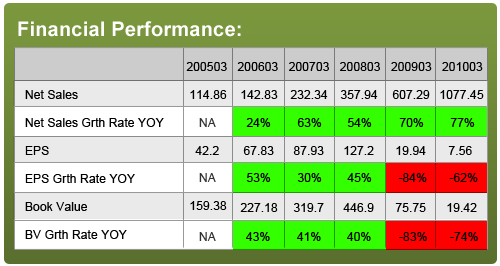
Market leader in the niche gold financing industry
Muthoot Finance is the largest player in the loan against gold (LAG) industry, both in terms of AUM and distribution network (1921 branches as of August 31, 2010. It enjoys an impressive 20 % market share in the Rs 65,000-crore organised gold loan market. The company has grown its market share by 9% CAGR in the last four years. The growth was a result of offering innovative schemes according to the needs of various customers.
Strong pricing power to ensure profitability
Customers of Muthoot Finance are typically small businessmen, vendors, traders, farmers and salaried individuals which form a part of the Indian population that is still deprived of banking services, despite huge initiatives taken by the commercial banks in India. They are charged exorbitantly high rates by moneylenders.
As the borrowers do not have access to commercial banking services, Muthoot wields a very strong pricing power. The lending rate for Muthoot is usually around 24-25%, which is significantly higher than what commercial banks charge but significantly lower than what local moneylenders would charge.
Speedy disbursals
The turnaround time at Muthoot Finance for a customer is roughly 5 to 10 minutes, something which is probably unbeatable by the banks due to procedural bottlenecks. Muthoot hires experienced personnel who understand the gold loan business, thus enabling every employee as an appraiser of gold, which entails quick disbursement of loans.
Aggresive expansion outside the southern region
Muthoot has been on an aggressive expansion mode especially outside the south. Over the past few years it has reduced its branch concentration in the southern region from 80% to around 70% in FY10. However, the AUM per branch is still slightly lower in the other regions, which is expected to improve with improved awareness about LAG.
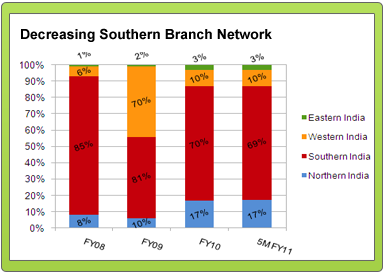
Increasing share of NBFCs in the underpenetrated LAG (Loan against Gold) Industry
The size of private gold holdings by Indian households is expected to be around 20,000 tonnes, of which only 10% has been used for gold loans. In spite of rapid growth in the gold loan segment in the last three to four years, its penetration in India remains under 1%. Thus, there is a huge untapped potential for LAG.
Also, the gold loan market is largely unorganized and dominated by pawnbrokers and money lenders, charging an exorbitant interest rate of 36% p.a. These can be substituted by cheaper, gold-secured loans from NBFCs. In fact, the share of organized market is growing rapidly to more than 25%, with emergence of specialized NBFCs.
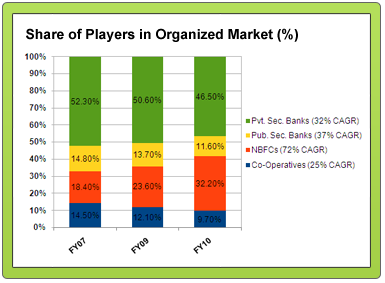
This huge untapped potential augurs well for NBFCs like Muthoot Finance in the LAG industry.
But what are the concerns?
Uncertainity regarding regulations
Any change in banking regulations related to gold loan NBFCs can damage the business. Proposed securitization guidelines from RBI can impact NBFC funding profile, leading to an increase in borrowing costs. Also the decision for Kerala Moneylenders’ Act (KML) is currently pending with the Supreme Court. If passed, it will give the state power to limit the interest rates charged by these NBFCs. Muthoot Finance’s portfolio exposure to Kerala market is around 16%.
Concentration of portfolio in one sector, one region
Muthoot derives 98% of revenues from the gold loan business. Also, despite aggresive expansion, concentration in the southern region continues to remain higher and is expected to remain so for the next few years. And it remains to be seen if the venture of NBFCs outside the southern regions proves to be profitable or not.
Increasing competition may result in margin reduction
NBFCs are facing increased competition from the banks, given the low entry barriers. This is bound to result in margin reduction given that NBFCs charge higher interest rates than banks.
Potential risk of brand-dilution
The widely known ‘Muthoot’ brand name is not exclusive to the Muthoot Finance. It is shared by other gold loan financiers, like Muthoot Fincorp of Muthoot Pappachan group, which could create some confusion in the market and pose a risk for Muthoot Finance.
Decrease in gold prices
If the gold prices fall, borrowers will be asked to put up margin money immediately. If that doesn’t happen, than the company can auction the jewelry immediately. However, steep fall in prices may affect the margins.
So, does Muthoot Finance IPO provide a golden opportnity for investment?
Muthoot Finance Ltd. is offering 5.15 Cr. equity shares (face value of Rs. 10 each) through the IPO at a price band of Rs. 160-175.
According to MoneyWorks4me.com analysis, we can expect that the company will continue to grow its revenue; but margins will most likely come down in near future due to increasing borrowing costs and increasing competition. Considering the growth prospects, we can expect the company to grow its book value at a rate of ~20% on an average, in the coming years. Also, it can be expected to trade at an PBV multiple of 3 going forward. At the current price band, the issue is priced at a PBV band of 4.04 and 4.13. Thus, at the IPO price band of Rs. 160- 175, the stock is almost fully priced – available at just 9 -10% discount to its right value. But, It is always better to invest in a company at an attractive discount (30-50%) to its right value. Considering this, we advice retail investors to avoid subscribing to the issue. However, Muthoot Finance is a fundamentally sound company and investors can look to invest in the company in the secondary markets when it is available at a 30-50% discount to its right value.
Disclaimer: This publication has been prepared solely for information purpose and does not constitute a solicitation to any person to buy or sell a security. It does not constitute a personal recommendation or take into account the particular investment objectives, financial situations or needs of an individual client or a corporate/s or any entity/ies. The person should use his/her own judgment while taking investment decisions.
If you liked what you read and would like to put it in to practice Register at MoneyWorks4me.com. You will get amazing FREE features that will enable you to invest in Stocks and Mutual Funds the right way.
Need help on Investing? And more….Puchho Befikar
Kyunki yeh paise ka mamala hai
Start Chat | Request a Callback | Call 020 6725 8333 | WhatsApp 8055769463


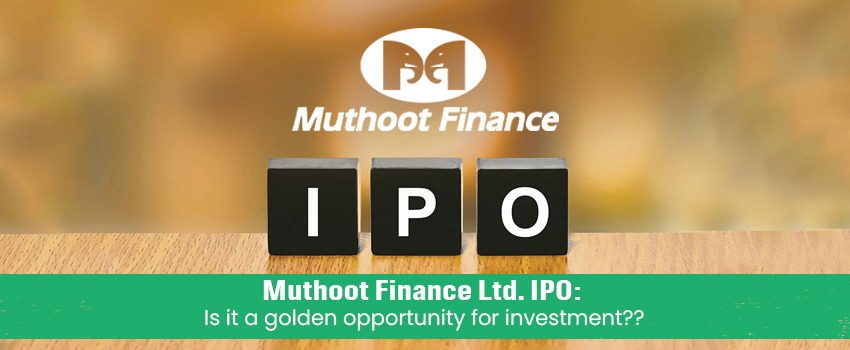
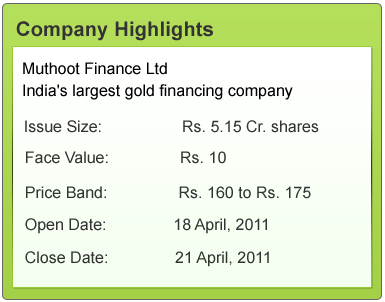
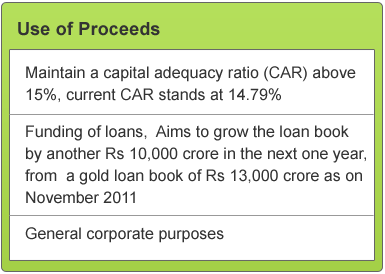








thanks for a pragmatic analysis on the IPO.Most other brokerages are gushing all over the place regarding this one.The hype might set the stage for listing gains as in the case of SKS Microfin,Coal India etc.Kudos to ur team for reading thru the fine print
Thanks a lot for the appreciation. We are glad that you have liked our analysis. Please continue reading and posting your feedback.
very good analysis of co and BOLD advise of NOT to subscribe when all others are advising to invest in this co .
Thanks for your appreciation. Do continue reading and posting your feedback.
Hi.
There are other reasons to be cautious about this co; corporate governance issues; the promoters want to reclaim the “Muthoot” brand name; and give it back on a non-exclusive basis @1% of the revenue; they have other companies in their group with similar business models which could result in a clash of interest; there are cases pending against the group companies which were not disclosed initially.and there is too much concentration of decision power in just one family.
Further, Gold loans are no more classified as priority sector, the cost of borrowing funds might go up.
You are right, the company does have all these concerns. As mentioned in the article, the changes in the RBI guidelines regarding gold loans not being classified as an priority sector lending will lead to an increase in borrowing costs. Regarding the royalty clause, there is no clarity on whether the company will act upon it. Also, there were a few litigations (12 against and 79 initiated by the company) which were not disclosed by the company which raises concerns regarding due diligence.
Thanks a lot for your appreciation. We are glad you liked our analysis. Yes, our site has been made with an aim to suit new as well as seasoned value investors.
Replying to your queries:
– The company has increased its equity base significantly in the last six years, which has led to an increase in its No. of shares and as a result its EPS and BVPS have witnessed a significant drop
– Book value is the total value available to the shareholders if the company is liquidated. Thus the total book value of the company will be shareholders equity plus the reserves i.e. shareholders fund.
– If the company has expertise and experienced professionals in the said verticals, diversifying would be a good idea. The returns and margins of such businesses will give us an idea of how profitable the business is.
– There is no past dividend history of the company
– It is better to remain well read on such family run business. As you mentioned, one should look for qualification and experience of the management. Going forward we can check the presence of Independent directors on the board and their linkages to the family members and if the management can deliver on its promises.
– Muthoot Finance is the market leader with 20% market share. Manappuram Gen. Fin is its closest competitor with a market share of 13%. It has a business model similar to Muthoot Finance. Other competitors are banks e.g. Indian Overseas Bank and Indian Bank etc. which enjoy the advantage of low interest rates.
Do keep reading and posting your feedback.
thanks for providing valuable and data based information regarding all aspects of stock market.